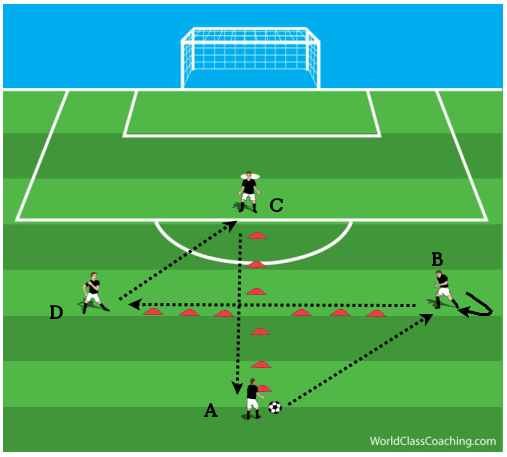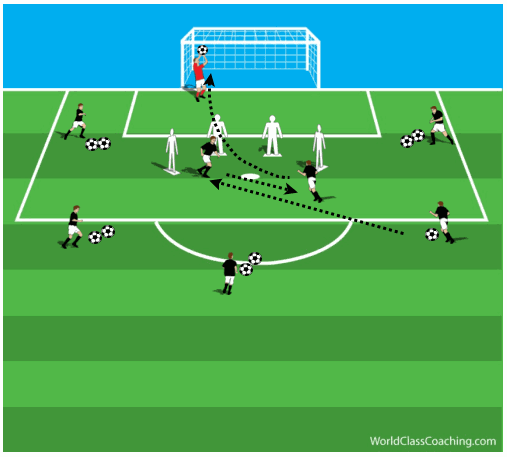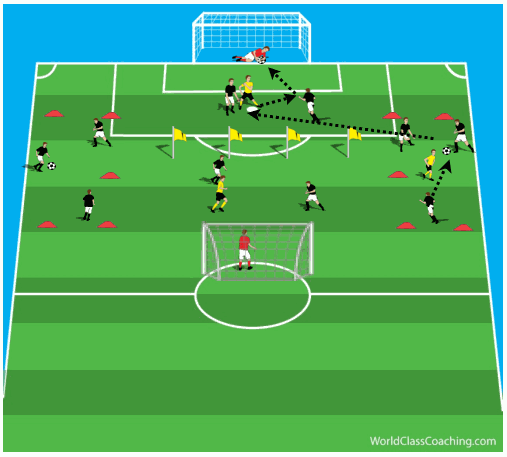By Chris Kouns
USSF A License (USSF Coaching Education Instructor) – NSCAA Premier Diploma (NSCAA Coaching Education Associate Staff Coach) – Head Coach Georgia Gwinnett College Women's Soccer
Activity 1
There are three sets of cones set up in a cross pattern (as shown below). The distances for the crosses are eight (8) yards – five (5) yards – two (2) yards. You will divide your team up into four groups with one group behind each of the four corners of the cross.
PATTERN
There will be two patterns to follow, but, they are basically the same just different directions. The first pattern will be repeat D – C – A – B – D. When switching to the other direction the pattern will repeat B – A – C – D –B. After players passes the ball then will rotate in a clockwise manner (even when the pattern direction switches)
RESTRICTIONS & COACHING POINTS
 1) As the ball travels to each player the next
1) As the ball travels to each player the next
player set to receive the ball should begin to check away and make physical contact with the player behind them in line. For instance as the ball travels from D to C player A will begin checking away and not
come for the ball until C is prepared to play it.
2) To help your teammates with the speed of play in combination (which is vital in the Box) players should receive the ball with the Foot that is across their body and take their first touch in the direction of the person they are playing the ball to.
3) For this to be successful all players must be paying attention to the body and eyes of the player on the ball. Make sure not to come to the ball until their body tells you they are prepared to pass it. Otherwise you will kill the space and not be able to recover from a bad ball.
4) After going in both directions focusing on receiving the ball across your body then assign pairs of lines specific feet they must receive the ball with. For instance D & B must only receive it with the left foot while A & C must only receive it with the right foot. Make sure both pairs have to do both feet.
PROGRESSION
Move inward towards the next smaller cross and follow the same directions. After successfully managing that cross go to the smallest cross. This one requires either two very fast touches or a one touch pass to be successful.
Activity 2
Set up four coaching figures (or even trash cans if you do not actually have the coaching equipment) in the area between the six yard box and the pk mark. Outside the six yard box (at the top) and then outside the 18 yard box positions five servers with at least three or four balls each. Then, place two players inside the area between the figures and the top of the 18. In succession serve balls to the players who must use what they worked on in the previous activity and play the ball into the path of their partner who will finish it one time if possible but two touch at most.
RESTRICTIONS
Any ball that the player checking for the first pass cannot control and play in one touch (or two quick touch max) does not earn them the right to finish. There is a premium put on playing balls quickly and with a purpose in the area so you can take advantage of the opportunities that arise. The next ball should not be played till the players in the middle are prepared to check away and receive the ball.
COACHING POINTS
 1) Each pair in the finishing area must work in tandem so that the player checking for the ball has their body open to an area where they can lay off a ball to be struck right away while their partner must read their body and adjust to be able to strike the lay off quickly.
1) Each pair in the finishing area must work in tandem so that the player checking for the ball has their body open to an area where they can lay off a ball to be struck right away while their partner must read their body and adjust to be able to strike the lay off quickly.
2) Encourage all types of creativity by the pair in the box. If the player checking for the ball does not see their partner in front of them have them prepared to find a way to make it work. Dummy the ball, flick it with a back heel, etc. This will
require communication between partners.
3) The player who is finishing the ball should take a peek at the space the “defenders” are giving them as finishing lanes and then make sure they put the ball on frame very quickly to take advantage of the fact they are so close to the goal and the GK will have limited reaction time.
PROGRESSION
You can increase the fitness component of this activity by giving each tandem a time limit to finish as many balls as possible in, however, I would not start that way so they can get a good grasp of what it takes in the box to finish first before worrying about speed. Also, you can make it a contest with the tandems each keeping track of their goals. You can give 1 point for a successful goal off a two touch lay off or finish and three points for a successful one touch lay off and finish.
Activity 3
This activity will require two full size goals facing each other at a distance of 46 yards (creating two finishing zones of 23 yards each). There will be two wide areas marked off with a 3 v 1 in each area (distances vary according to the technical and tactical level of your players). Within each finishing area there will be a 2 v 1 plus a GK.
RESTRICTIONS AND SCORING
Both 3 v 1 grids are keeping possession at the same time. When they are prepared to play an entry pass into one of the finishing areas they can play the entry ball. Make sure your grid for the 3 v 1 is big enough to allow them to successfully keep possession and still offer visual cues for the attacking tandem to read and check off of. 3 v 1 is allowed to play to either attacking tandem so their body position should be open to either option. When the tandem gets the ball their focus is to be able to finish in less than two touches per person.
ADAPTATION – If your players are having a hard time focusing on where to go and who to check to because there is too much activity you can just have one 3 v 1 grid active at a time. Then, when a ball is played in to one attacking tandem the other 3 v 1 grid can become active and will play in the direction of the other tandem.
COACHING POINTS
 1) As the players are keeping possession in the 3 v 1 grids the attacking pair should be moving to create a “scoring” pocket where they can check into and receive the ball with enough room to
1) As the players are keeping possession in the 3 v 1 grids the attacking pair should be moving to create a “scoring” pocket where they can check into and receive the ball with enough room to
lay off and finish.
2) Ideally the attacking tandem player who is closest to the defender should drive them away by putting their shoulder in their chest. Then, that offers a visual cue to their partner to begin preparation of their body for a shot. They should
also begin to read the space where the shot will most likely take place so they can choose their finishing area in the goal.
3) Players in the 3 v 1 grid should work to put themselves in positions where they can play a positive entry ball into the attacking pair. This requires them to keep their heads up, receive the ball in a positive manner going forward when facing the attacking tandem and focus on playing a ball that can be handled in one or two touches max.
By Chris Kouns: USSF A License (USSF Coaching Education Instructor) – NSCAA Premier Diploma (NSCAA Coaching Education Associate Staff Coach) – Head Coach Georgia Gwinnet College Women’s Soccer (GA)


